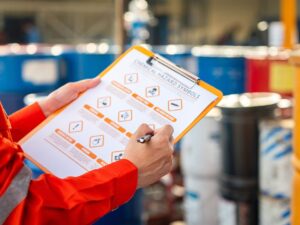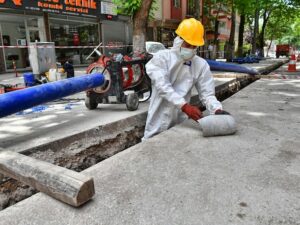
The use of virtual and augmented reality in safety training and risk assessment
Did you know that, internationally, companies outlay an average of $18 billion due to non-fatal workplace injuries? It’s no wonder occupational health and safety practitioners are constantly searching for ways to make workplaces safer. A serious game-changer has been the industrial application of virtual reality and augmented reality. In this article, we look at how the two differ, how Toyota and 3M are improving safety in their workplaces using VR and AR, and three benefits of investing in VR safety training.
How do Virtual Reality and Augmented Reality differ?
Virtual Reality involves the trainee wearing a pair of goggles with internal displays. Once activated, these goggles present a different ‘world’ to the wearer. VR technology allows the trainee to look around, getting a 360-degree view of their surroundings. In the case of industrial VR applications, wearers can interact with realistic warehouses, refineries, construction sites, and even virtual versions of their current workplaces.
Augmented Reality is different in that a virtual world is not created, taking the wearer away from the real world completely. Instead, users hold up a device, like a phone or tablet, and a virtual object is rendered on the real-world surface. Snapchat, the popular social media app, uses AR in its filters and lenses to change a person’s appearance by overlaying makeup, clothing and other items.
VR training for machine risk assessments at Toyota
Toyota Motors, through a 3rd-party VR developer, developed a Virtual Reality training program that teaches workers about assessing risks associated with new equipment to be introduced to their factories.
The VR app allows individuals to view a large mechanical piece of equipment virtually, like a robotic arm, that poses potential safety hazards. In each user’s session, the app selects a set of potential hazards that they can explore and assess.
The VR program was built to randomly select subsets of hazards each time a worker undergoes training, which introduces a replay ability. In other words, the worker being trained won’t see the same hazards each time, which enhances their understanding by allowing them to gain additional safety insights.
VR training to prevent workplace falls at 3M
Slips, trips and subsequent falls are extremely common workplace accidents across the planet. Luckily, the biggest brands are using technologies like VR and AR to minimize the risk of falls.
3M has developed a Virtual Reality worker health and safety training program that has one purpose: to prevent accidents due to falls in their factories and warehouses.
The immersive virtual environment trains workers on the importance of wearing appropriate personal protective equipment (PPE) while at work, including helmets and harnesses when working at heights as is common on construction sites.
A final word on the use of virtual and augmented reality in safety training
While learning in a virtual environment gives the option of experimentation, it can also reduce the damage that can be caused during training in a real environment. Human errors during real-world safety training can be life-threatening. With the flexibility and possibilities that AR and VR bring, safety training will be greatly improved and become more effective once their applications are widespread.
Book Occupational Hygiene Training Association (OHTA) training courses
It might be a while still before most workplaces in Africa can enjoy the benefits of VR safety training for their employees. However, current OHTA training courses still provide an international standard of workplace safety training delivered in an engaging, hands-on manner. Contact Apex Environmental today to book any of the below OHTA training courses:
- OHTA W201 – Basic Principles of Occupational Hygiene
- OHTA W507 – Health Effects of Hazardous Chemical Substances
- OHTA W501 – Measurements of Hazardous Chemical Substances
- OHTA W503 – Noise: Measurement and its Effects (conducting noise risk assessments)
- OHTA W505 – Control of Hazardous Chemical Substances
- OHTA W504 – Asbestos and Other Fibers
- OHTA W506 – Ergonomics Essentials
- OHTA W502 – Thermal Environment








